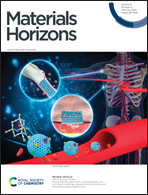Triplet–triplet annihilation upconversion with reversible emission-tunability induced by chemical-stimuli: a remote modulator for photocontrol isomerization†
Abstract
Triplet–triplet annihilation upconversion (TTA-UC) has been widely studied, but a color-tunable TTA-UC system triggered by chemical stimuli has not yet been proposed. Herein, reversible acid/base switching of the TTA-UC emission wavelength is achieved for the first time by a simple platform, composed of a direct singlet–triplet (S0–T1) absorption photosensitizer, and proton-responsive 9,10-di(pyridin-4-yl)anthracene (DPyA) as an acceptor. The photosensitizer–acceptor pair exhibits efficient UC emission (quantum yield up to 3.3%, and anti-Stokes shift up to 0.92 eV) with remarkable contrast upon base/acid treatment (Δλem,max = 82 nm, 0.46 eV). In a proof-of-concept study, the color-adjustable TTA-UC emission was applied as a remote modulator to photo-control reversible chemical reactions for the first time. This platform enriches the portfolio of color-switchable TTA-UC, and the mechanism would inspire further development of smart UC systems and extend the application field of upconversion.



 Please wait while we load your content...
Please wait while we load your content...